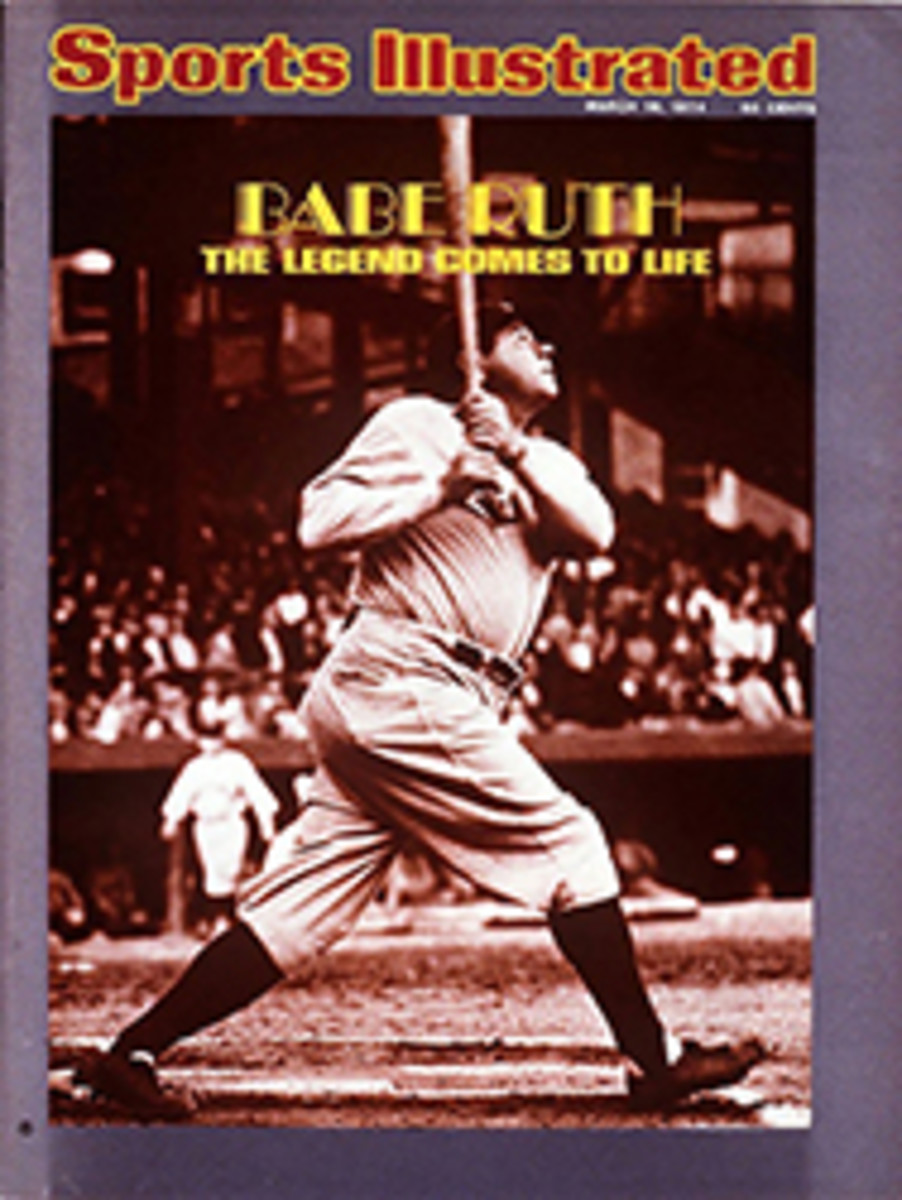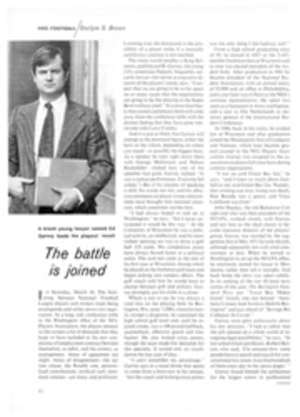
SCORECARD
PROGRESS OR PERIL
If the NFL Players Association succeeds in eliminating the option clause during negotiations beginning this week with management (page 62), the next move, Executive Director Ed Garvey hints, might be toward a worldwide union of professional athletes, maybe even including college students on athletic scholarships. "Why not?" asks Garvey. "We expect to merge with the Canadian players group as well as take on the players who join the World Football League."
Probably this is only a trial balloon. Garvey likes this sort of thing. But it is a disturbing prospect with plenty of why nots?—concerning bigness, individual freedoms, international cartels and reprisals, to mention a few.
CEASE SAFARI
It is now official. The day of the big-game hunter with his high-velocity rifles and a file of native porters is finished in Tanzania. In the future, the only shooting in the land Ernest Hemingway hunted—and later wrote about in Green Hills of Africa and The Snows of Kilimanjaro—will be with cameras.
Appalled by the slaughter of elephants and other wildlife through widespread killing by gangs using modern weapons and powerful trucks, President Julius Nyerere's government last September imposed a six-month ban on all forms of commercial hunting. The ban has been made permanent.
Tanzania's 11 million tribespeople still will be permitted to kill game to feed their families. "But the villagers will be issued a list of animals they can hunt for food," said B. Mulokozi, principal secretary in the Bureau of Natural Resources and Tourism. "Of course, we can't allow them to kill every animal."
Mulokozi said that professional hunters would no longer be able to operate and that serious measures would be taken against anyone found selling or buying such game trophies as elephant-foot umbrella stands, zebra-skin billfolds and antelope-leg bedside lamps. No loss.
A spokesman for an old established safari firm in neighboring Kenya believes the hunting ban probably is going to cost Tanzania thousands of pounds a year in lost tourist trade. "A lot of white hunters in that country already have left," he says, "and the rest are leaving for jobs elsewhere."
COUNTRY MILE
It is not just Little Leaguers who are swinging aluminum bats these days. The NCAA approved their use for college baseball in 1974, and if what is going on at the University of Texas is an omen, there are going to be a lot of shell-shocked pitchers this spring. Keith Moreland, an All-America at third base last year, was batting .628 after the Long-horns' 13th straight win of the season. Through one eight-game stretch he hit .777 with 21 of 27.
"The ball seems to jump off the aluminum bats better," he says. "In some of our home games this year there have been balls that would have been ordinary flies had they been hit with a wooden bat. But with the aluminum they carried out onto the cliff behind left field."
There is one drawback to aluminum, the Longhorns report. Since the bats come in only three sizes, all with the same size bat handle, players frequently hand the bat to the succeeding hitter. "It looks kinda country when six guys in a row use the same bat," Coach Cliff Gustafson says.
GOT THE HORSE RIGHT HERE
The horse population, far from dwindling, may be outpacing humans, The Christian Science Monitor reports. According to the Department of Agriculture and other statistical assessors, horses for riding, racing, showing, hunting and even polo, surprisingly, appear never to have heard of zero population growth. In 1960 it was estimated that there were 3 million riding horses in the United States. Now Agriculture has kicked the figure up to 6.5 million, but riding clubs are saying it is more like 10.5 million, or a horse for every 20 persons.
Trail riding over some 100,000 miles of paths in 154 national parks and 19 national grasslands as well as countless smaller trails is the fastest-growing horsey activity among the young. Forty percent of riding-horse owners are under 20. Between 250,000 and 500,000 children are in 4-H riding programs, compared with 80,000 in 1960.
Some more figures: 500 major horse shows are held each year. There are 91 polo clubs around the country, 31 of them less than 10 years old; 108 fox hunting clubs; 65 associations concerned with special breeds; and the number of horses bred for racing increases every year.
An advertisement that ran recently in a Boston newspaper sums up the new enthusiasm: "Young woman with experience wanted to help care for young baby and five horses."
TWO KINDS OF COMPETITION
In all sport there is almost no word more sacred than competition. Devoted adherents have been known to ascribe to it most of what is good and successful in U.S. society. Recently, though hardly going that far, a professor of physical education at Pennsylvania's Slippery Rock State College, David Auxter, said that since competitive athletics are desirable, women should be cut in on the good deal, which he described as an educational experience. "Better athletic programs will develop more aggressive females, women with confidence, who value personal achievement and have a strong sense of identity. I think that would be a good thing for us all."
Another view comes from two physical educators at the University of Connecticut, Drs. Hollis Fait and John E. Billing. Noting that in competition there are far more losers than winners, they say, "If maximum development of all students is desired, direct competition, by its very nature, negates this goal.
"When physical educators use direct competition, in which significant numbers must inevitably fail," they write in a new book, Issues in Physical Education Today, "we induce many students to avoid failure rather than to seek success. The student seeking to avoid failure never attempts anything of his own volition; he never volunteers, takes an extra trial or ventures an idea in response to a question. In fact he may actively avoid participation, for he cannot fail if he does not attempt."
Rather than stress athletic contests, Drs. Fait and Billing suggest, physical educators should encourage self-development through indirect competition, such as improving one's own performance. Almost nobody is a loser that way, and the majority will know what it is to succeed.
Is there some reason that escapes us why physical educators refuse to allow us to compete or not, as we choose?
PATRIOT?
The Washington, D.C. entry in the World Football League recently held a naming contest and, out of 15,000 nominations, came up with Ambassadors. Since this was suggested by a number of people, the WFL put the eight with the earliest postmarks in a hopper, and the winners picked out were Mr. and Mrs. Richard S. Berardino of Laurel, Md. Team Owner Joe Wheeler presented Mrs. Berardino with a $1,000 check at a luncheon, after which Mr. Berardino set the record straight: his wife had nothing to do with their choice. He had sent in several suggestions, and his personal preference was not Ambassadors but Spartans. Furthermore, crunch, "At heart, I'm a Patriot fan."
DON'T DO THAT!
An insidious plot is afoot in the harness racing world that is going to make strong men quaver and the rest of us cross-eyed if somebody doesn't draw a rein on this thing right now. Trainer-Driver Roger Brown has a prize 2-year-old colt whom he has named H. C. Tapnad. Read that backwards and, if you don't retch, you will notice it is Dan Patch.
At last count there were not many people reading the tote board backward, although some may have thought they had. Think of the brouhaha, writes Columnist Earl Flora in Hoof Beats, if the harassed bettor were faced with a card with the likes of E. D. Irpsrats, S. S. Ortabla and R. E. Vonahterb, not to mention Y. K. Cutnek, L. E. Ehrat and D. R. Ybeybeyb.
Bad, eh? It gets worse. Ted Taylor's 3-year-old gelded son of Below Zero is named Tubelo Zero. United States Trotting Association, W. O. NTCA!
FIVE BY FIVE
Fuel conservation note: San Diego's Pacific Power Boat Club, which had been running three-lap races for hydroplanes and runabouts around a 1‚Öî-mile course, shortened each lap to a mile. Then it discovered that on one-mile courses only races of five or more laps qualified for championship points. So it added two laps. End fuel conservation.
WAY, WAY DOWN EAST
Maine has been having the kind of winter energy czars dream of—and snow-sport promoters dread. The latest casualty: the 50th anniversary International Snowshoe Congress. With no snow, the webfoots raced on dirt. There was a brighter side, though. Asked if she were going to open her golf course on March 15, Mrs. Lowell McLaughlin, the shop supervisor at Scarborough's Pleasant Hill Country Club, said, "Open? We haven't closed since last March 15."
TO HAVE NOT AND TO HAVE
Even Commissioner Pete Rozelle has acknowledged that the National Football League draft needs work (SI, Feb. 11). Designed to equalize team strengths by giving bottom clubs first go at the year's college crop, it succeeds merely in giving the worst team first pick, if indeed that has not already been traded away. Because of the size of the league, the following choices by poor teams are far down the line (27, 53 and so forth), and not about to turn any franchise's fortunes around. For real equalization, the more vociferous critics of the league have suggested, the have-nots should be awarded up to five selections among the first 25.
But maybe such drastic surgery is not required after all. Rozelle's office has delved further into the matter and has decided that the poor do get richer—but by increments, not in dramatic leaps. By dividing the league into lower and upper halves and comparing their 1972 and 1973 records, Director of Personnel Jan Van Duser, together with his assistant, Carl Marasco, discovered that the 13 teams in the lower half in 1972 won 24 more games in '73, while the teams in the upper half were losing 26 more than they had in '72.
"I submit no magic reasons to explain the figures," Van Duser says. "The undeniable fact keeps showing up that despite the presence of variables which can tilt a competitive system in either direction—coaching, personnel evaluation, lack of early-round choices, injuries, luck, sunspots or what have you—the trend of increased losses for the better clubs is real."
Van Duser concedes that there are some who always land in the top half, and there is Houston, which seems good for at least one win a year. But he also points to eight have-nots of 1968: Cincinnati, Atlanta, Denver, Minnesota, Miami, Buffalo, Pittsburgh and Washington. They all drafted among the haves in January.
ILLUSTRATION
THEY SAID IT
•Tommy Harper, Boston Red Sox outfielder: "I found out something this winter. If you sit next to Henry Aaron at banquets, you get your picture taken a lot."
•Dave DeBusschere, the N.Y. Knick forward, on his career in baseball: "My greatest achievements involved other players. I was pitching for the White Sox against Cleveland the day Early Wynn got his 300th victory. And at the beginning of the 1963 season the White Sox had to choose between two pitchers. They kept me and traded Denny McLain to Detroit."
•William Wimpsinger, International Machinist Union officer, speaking to the National Football League Players Association: "If you are going to strike, I don't think the owners can get scabs."
•Lili Ledbetter, 12-year-old who has run a 3:03 marathon: "Sometimes people ask me why I run, and that bothers me. You don't ask football players why they play football."

